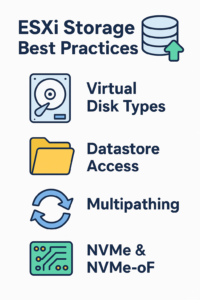
👋 Hey VMware Gurus!
So far in our vSphere 9.0 performance series, we’ve mastered the hardware foundation, tuned our CPU scheduler, and optimized memory. Now it’s time to tackle what’s often the biggest bottleneck in any virtual environment: storage.
Delivering consistent, low-latency storage I/O is the key to happy applications and happy users. In this post, we’ll dive into the ESXi storage stack and explore best practices for:
✅ Virtual disks
✅ Datastore access
✅ Multipathing
✅ Modern storage protocols

🗂 Virtual Disk Types: Thick vs. Thin
1. Thick Provision Eager Zeroed (Performance Champion)
-
✅ Best performance from the first write
-
❌ Longest creation time
-
🔑 Use with latency-sensitive apps (databases)
2. Thick Provision Lazy Zeroed (Balanced Option)
-
✅ Faster creation than Eager Zeroed
-
⚠️ First-write penalty (reduced in vSphere 7.0 U2+)
3. Thin Provision (Space-Saver)
-
✅ Saves storage by growing as needed
-
❌ Must monitor datastore capacity
-
🔑 Best for VDI, templates, and test/dev
💡 Verdict: Use Eager Zeroed Thick for mission-critical workloads; use Thin Provisioning for efficiency on modern arrays.
⚡ Unleash Your Array with VAAI
If your array supports vStorage APIs for Array Integration (VAAI), ESXi will automatically offload heavy lifting:
-
ATS (Hardware-Assisted Locking): Faster VMFS operations
-
XCOPY (Full Copy): Offloads clone & vMotion to the array
-
Block Zeroing: Speeds up provisioning of disks
-
UNMAP: Reclaims deleted VM space on thin-provisioned storage
🔀 Multipathing: More Paths = More Performance
Path Selection Policies (PSPs):
-
MRU (Most Recently Used): Best for Active/Passive arrays
-
Fixed: Best for Active/Active arrays
-
Round Robin (RR): Best for performance – load balances across paths
💡 Pro Tip: Always check your vendor PSP recommendation—sometimes their plugin beats VMware’s defaults.
🚀 Embracing Modern Storage: NVMe & NVMe-oF
-
NVMe: Built for flash, use the High-Performance Plug-in (HPP)
-
NVMe-oF: Extends NVMe speed across fabrics, with HPP as the default
⏱ Latency-Sensitive Storage Workloads
For ultra-low latency workloads:
-
⚡ Set Host Power Policy to High Performance
-
⚡ Disable CPU C-states in BIOS to reduce wake latency
🔮 Up Next in the Series
We’ve conquered CPU, Memory, and Storage. Next, we’ll unlock the final piece of the puzzle: Advanced Networking in vSphere 9.0—from virtual switches and NIC teaming to SR-IOV and latency tuning.
💬 What’s your biggest storage performance win or woe? Drop your story in the comments!


